Learn how to nixtamalize corn for tamales, the age-old process that results in the most incredible masa from scratch. This authentic tradition is the secret to tamales with unrivaled texture and flavor! In this post, I walk you through all the steps so you can master this process at home.
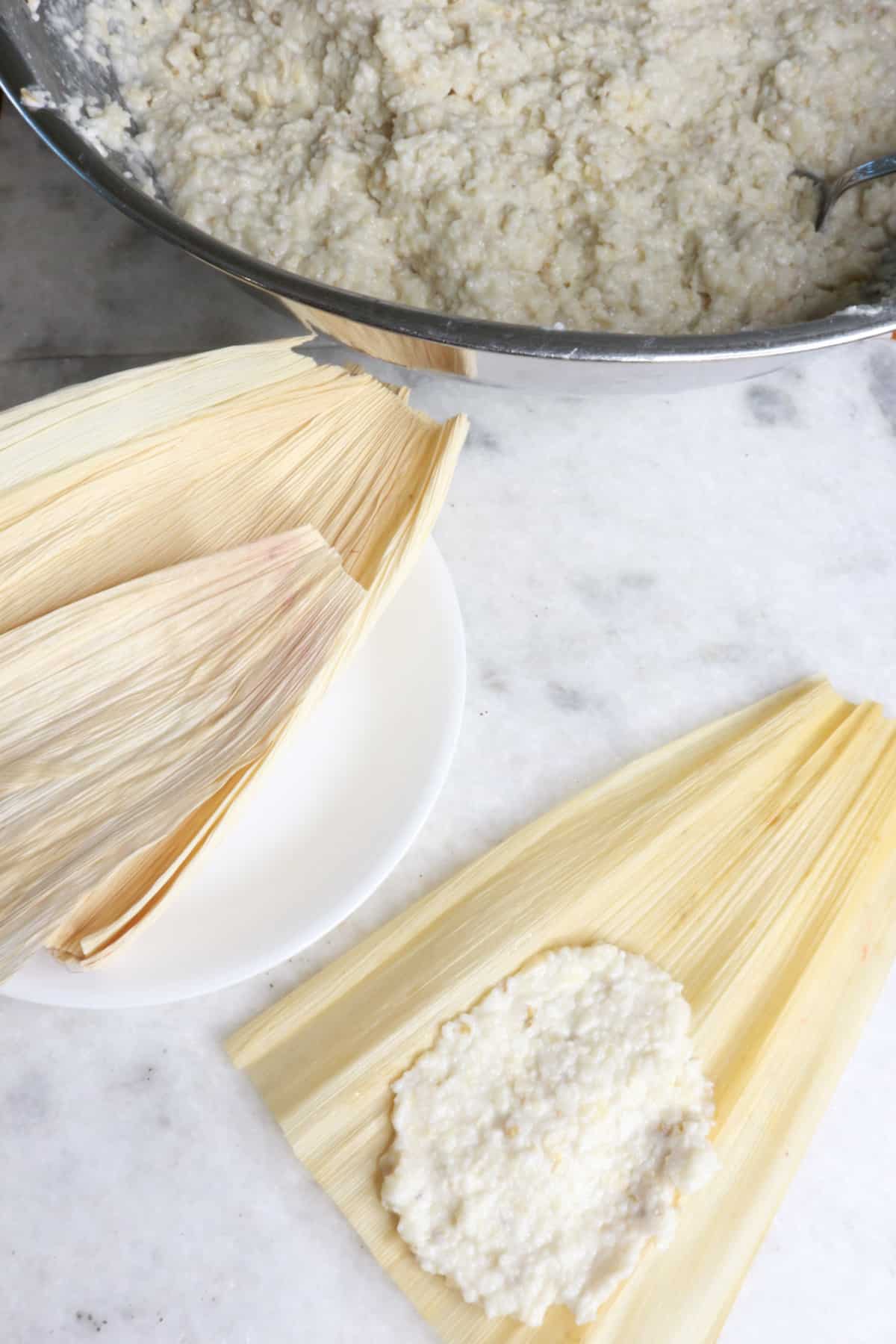
Pre-made masa harina is great for making food like homemade tortillas or sopes, but when it comes to tamales, there is nothing like fresh masa made with nixtamal, also known as nixtamalized corn.
My dad has been following this process for years and it sets my parents' tamales apart from any others I have tasted, with the most incredible, fluffy texture and an amazing flavor.
For today's post, my dad walked me through the detailed steps of nixtamalizing corn and creating the masa (dough).
So keep reading to learn about this traditional process and learn how to make the best masa for tamales.
Jump to:
What is nixtamalization?
Nixtamalization refers to the process of soaking and cooking dried corn kernels in a water and alkaline solution, usually made with lime (calcium hydroxide) or wood ash.
During nixtamalization, the alkaline solution softens the outer shells of the corn kernels. This not only makes removing the shells and grinding the corn easier, but also enhances its flavor, texture, and aroma.
This ancient technique originated in Mesoamerica and is the process necessary to prepare masa for corn-based foods, like tortillas, tamales, sopes, and more.
Nixtamalization also ensures the corn is safe for our consumption and enhances its nutritional value, including its bioavailability of vitamin B3 niacin, iron, and calcium.
Why You'll Love This Recipe
- Incredible Texture The nixtamalization process results in a tender, fluffy texture, resulting in perfectly light and airy tamales.
- Amazing Flavor: Nixtamalizing the corn brings out an earthy, and slightly nutty flavor that's so much more complex and better than any store-bought masa harina. This process truly transforms your tamales from good to extraordinary!
- Nourishing: Nixtamalization actually increases the corn's nutritional value.
- Homemade and Traditional: This recipe teaches you the rich culinary tradition and techniques passed down through generations. Plus, there is something so satisfying about creating foods from scratch and being in control over the ingredients used.
Be sure to use this masa when making Green Chile and Cheese Tamales, Tamales Rojos or Tamales de Frijol.
Ingredients & Substitutions
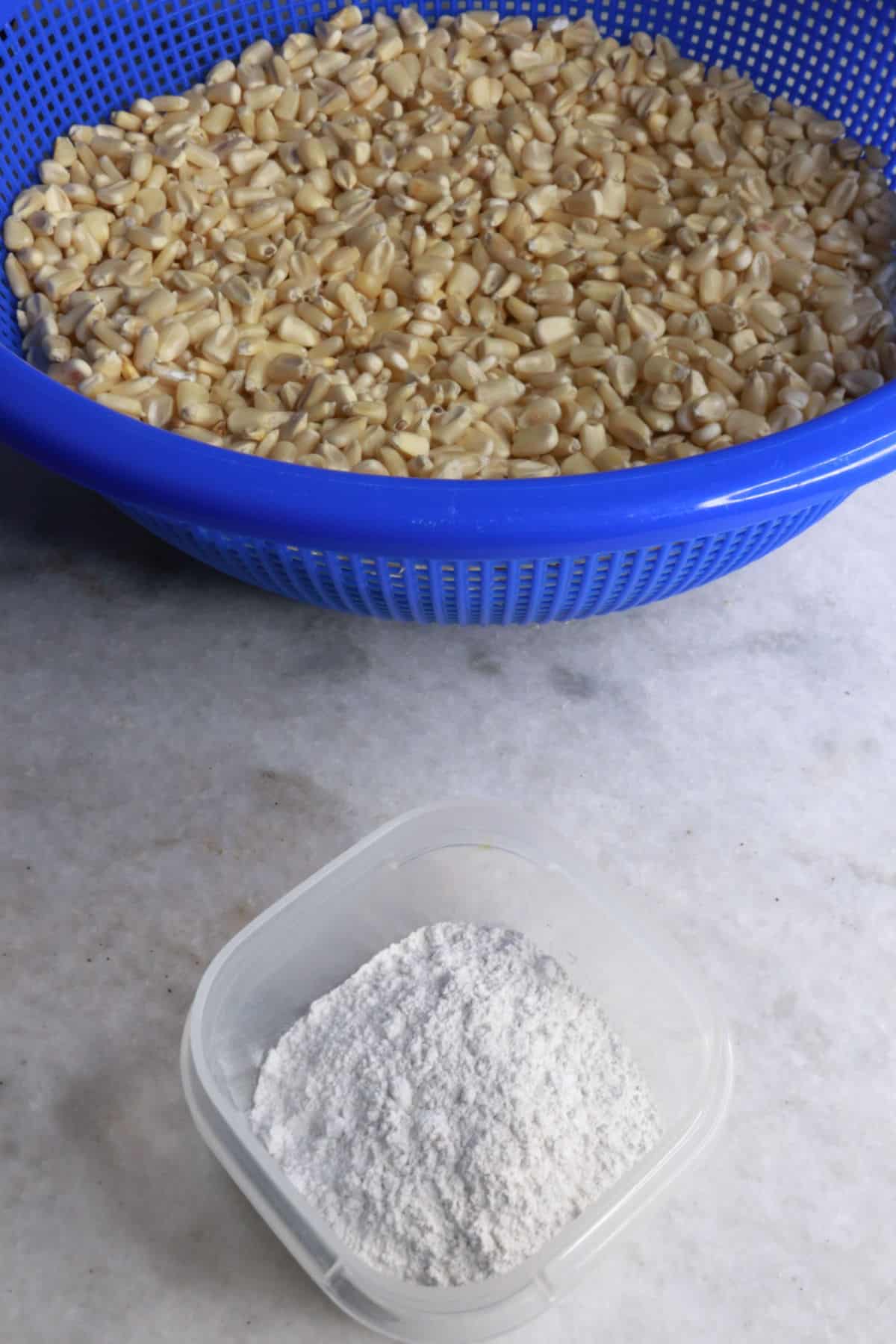
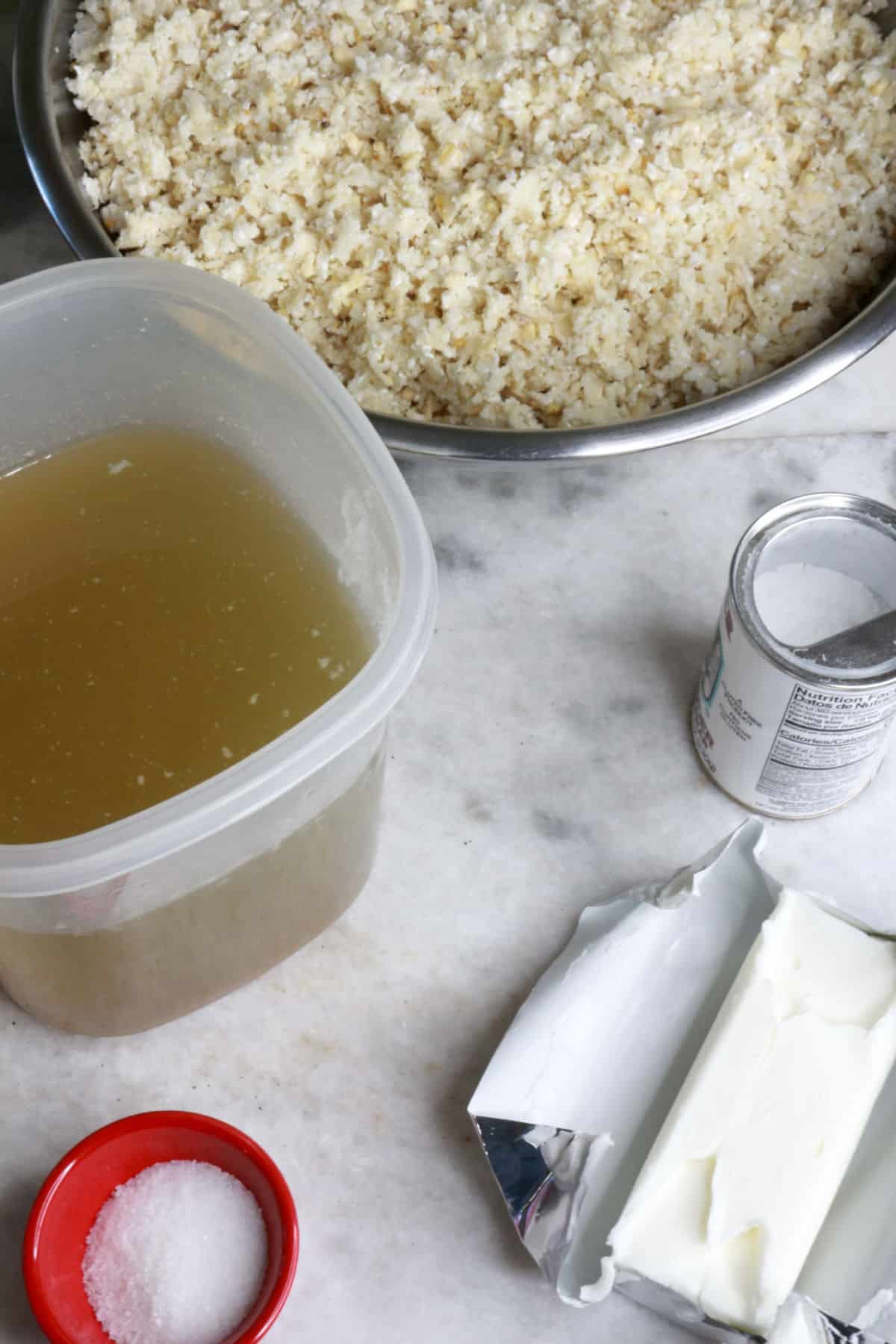
- White Olotillo Corn is a special heirloom corn with bright white kernels. It is known for its earthy, slightly sweet flavor and its texture is ideal for masa. My dad usually buys this white, whole-kernel corn at local tortillerias (tortilla shops) or it also can be ordered from the company Masienda.
- Calcium Hydroxide, also known as hydrated lime, pickling lime, or "cal", is the key ingredient in nixtamalization. Cal is used to soak and cook the corn, which softens the kernels, and increases the nutritional content and flavor. You can find cal in Latin American stores, or stores like Walmart, Ace Hardware, or on Amazon.
- Water is used to soak the corn during nixtamalization.
- Broth: Broth is used to moisten the masa and create the creamy consistency. We always use the pork broth from the meat we use as a filling, which adds amazing flavor and fat. However, you could use vegetable broth as a vegetarian option or chicken broth.
- Shortening or Lard: We usually use vegetable shortening, but lard also works. The fat is kneaded until silky smooth and combined with the ground corn to create a moist and tender texture that is essential for the perfect masa.
- Baking Powder helps give the final tamales a light and fluffy texture.
- Salt: The right amount of salt is essential to enhance the overall flavor of the masa and tamales.
See recipe card for quantities.
How to Make Nixtamal
Nixtamalizing the Corn
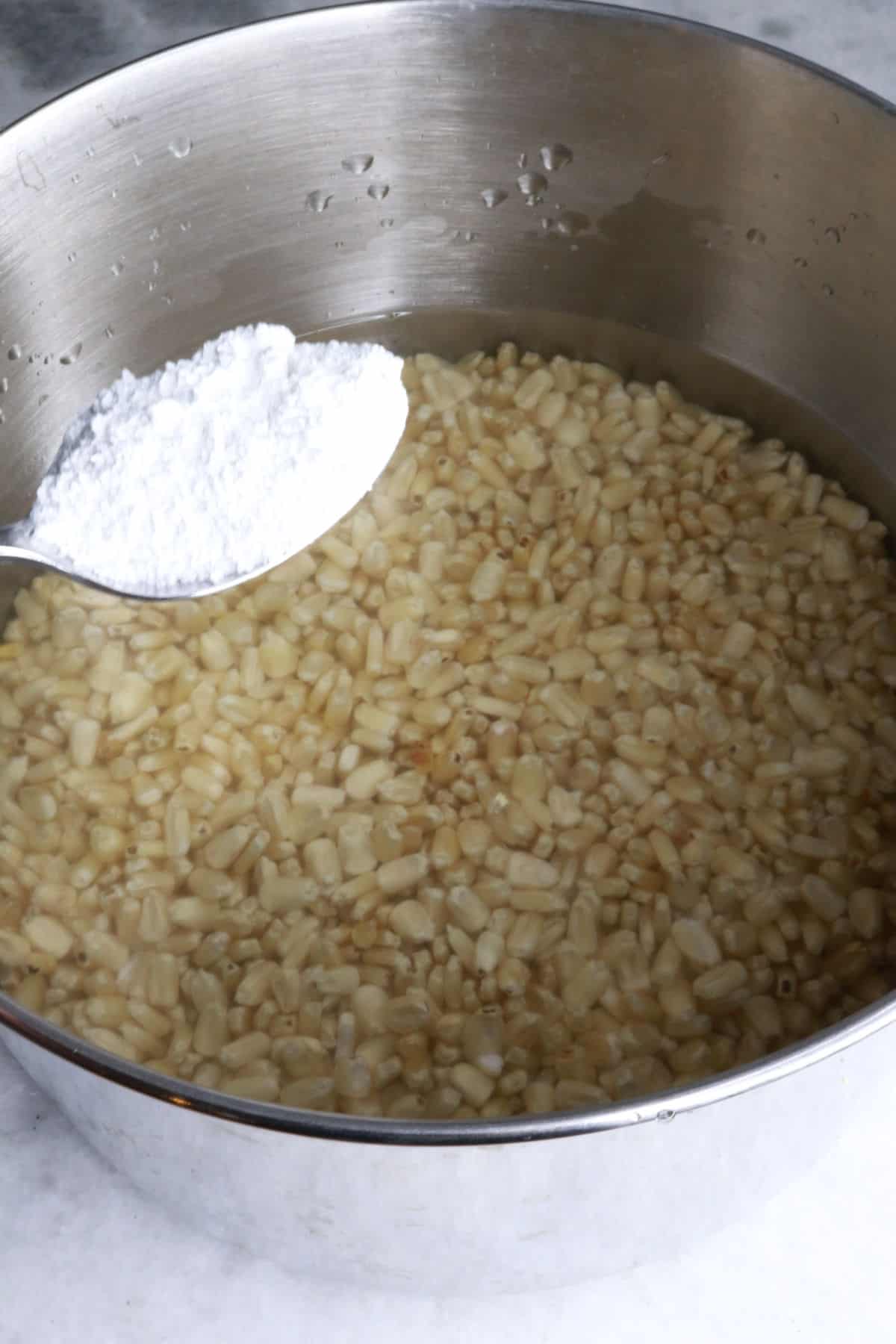
1. Boil Corn: Add corn and water to a large pot. Mix in cal. Bring to a boil and simmer uncovered for about 2 ¼ -2 ½ hours, or until the skins of the corn easily rub off between your fingers and the corn is al dente (medium-soft) when you bite into it.
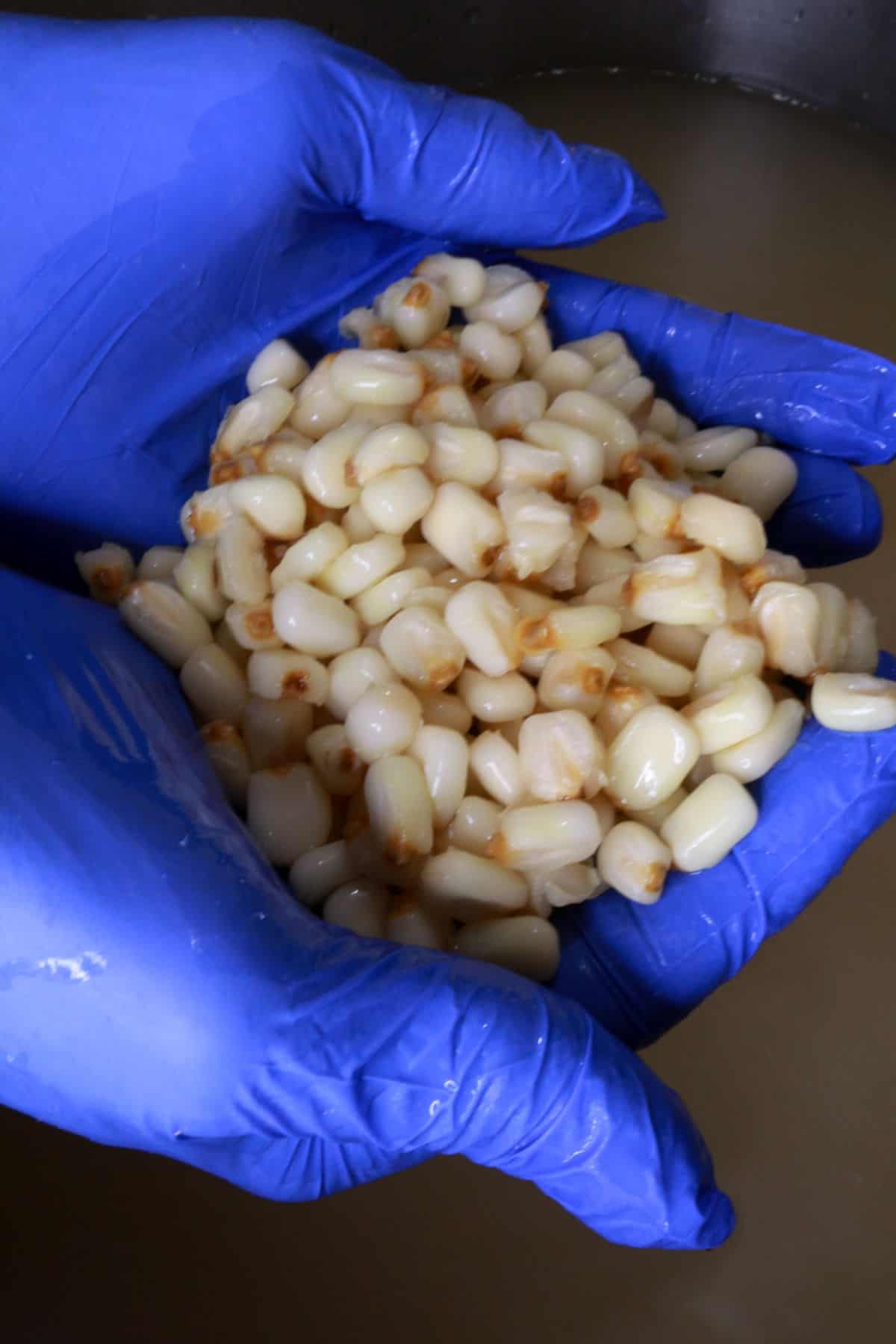
2. Steep: Remove the pot from the heat and submerge it in an ice bath to stop the cooking process. Let the corn sit in the pot for 8-12 hours to allow the corn to steep in the cal solution, completing the nixtamalization process.
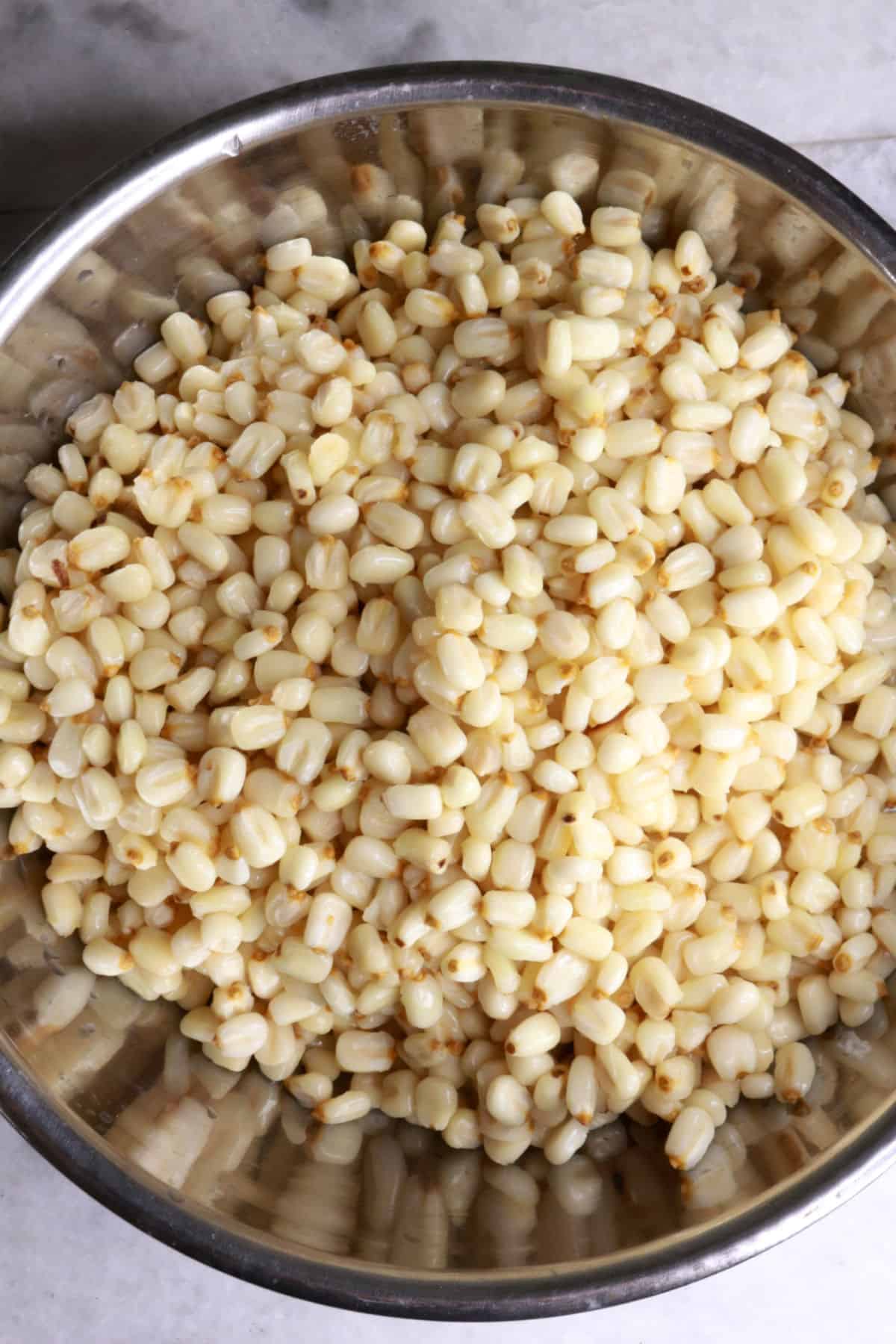
3. Drain and Rinse: Drain the corn and rinse under cold water. While rinsing, rub the corn pieces between your hands so that the outer skins fall off.
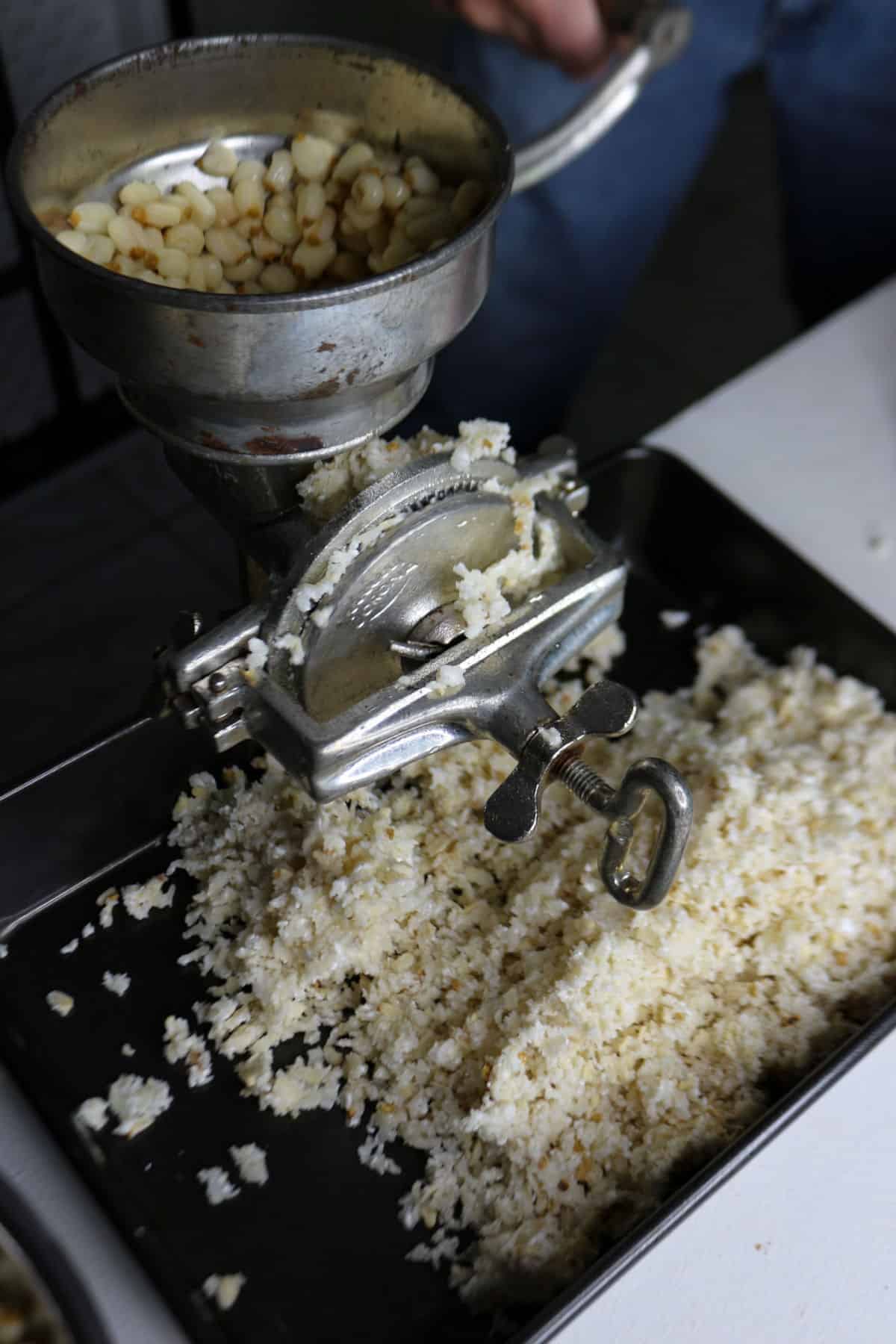
4. Grind: Use either a hand-cranked grain mill or an electric corn mill (or molino) to grind the corn in batches so no big pieces of corn are left. The texture should be coarse, and not fine like store-bought masa harina.
Making the Masa
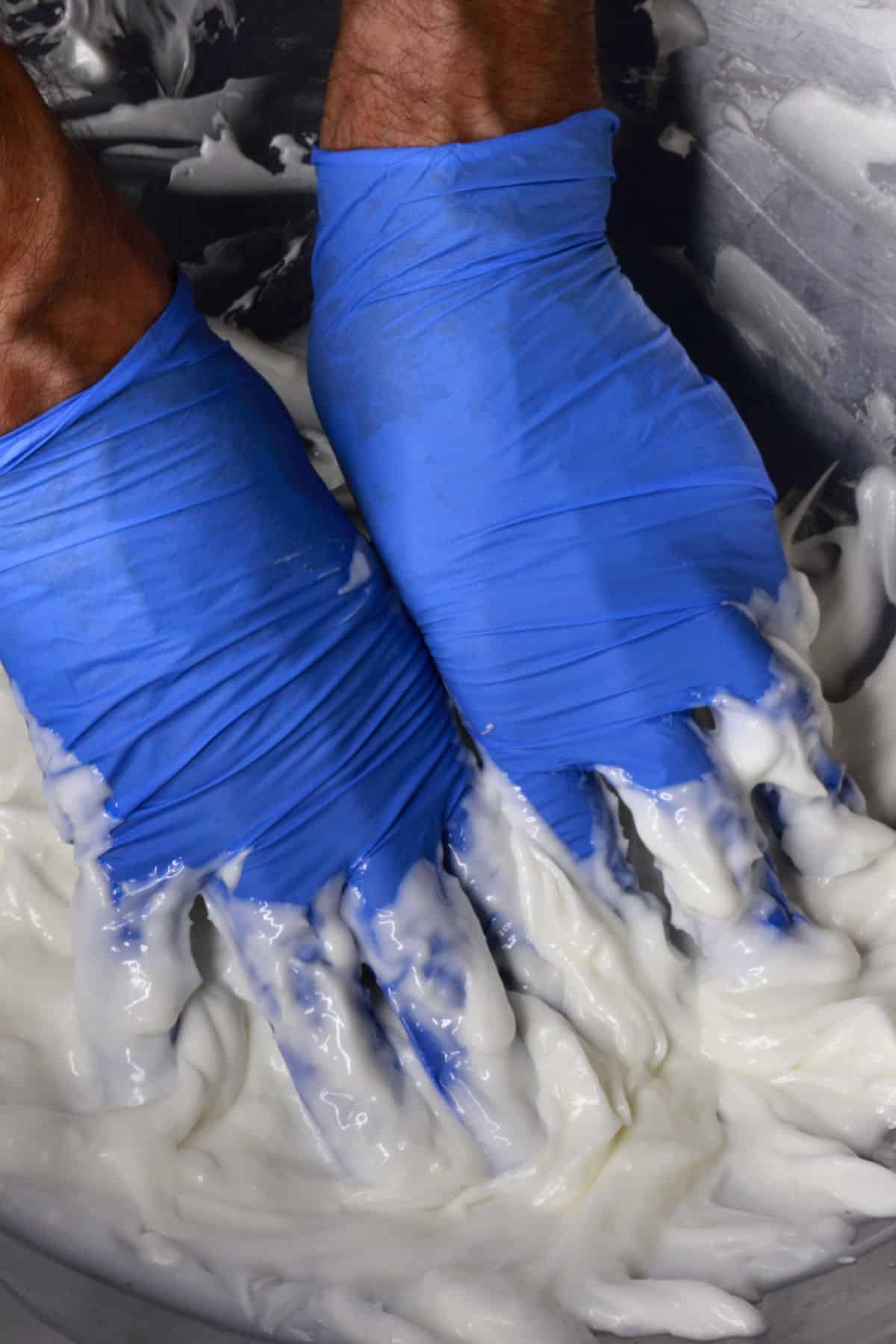
5. Knead Shortening: Place shortening in an extra-large mixing bowl. With clean hands, knead continuously for about 15-20 minutes until the shortening is soft and creamy-smooth.
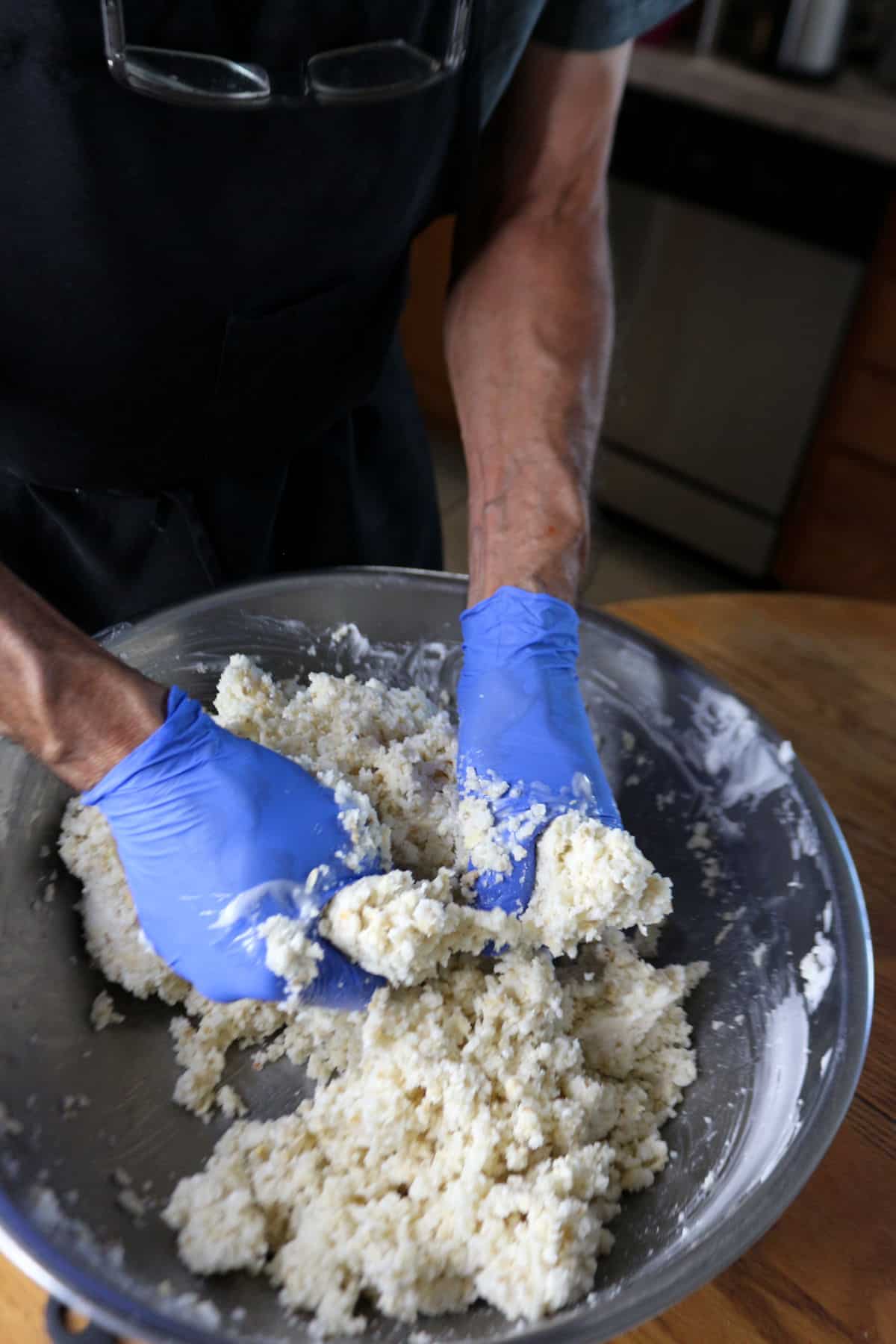
6. Mix Dry Ingredients: Add salt and baking powder to the ground corn and mix to incorporate well.
7. Combine Ingredients: Slowly add the ground corn flour to the shortening and mix with your hands until well combined.
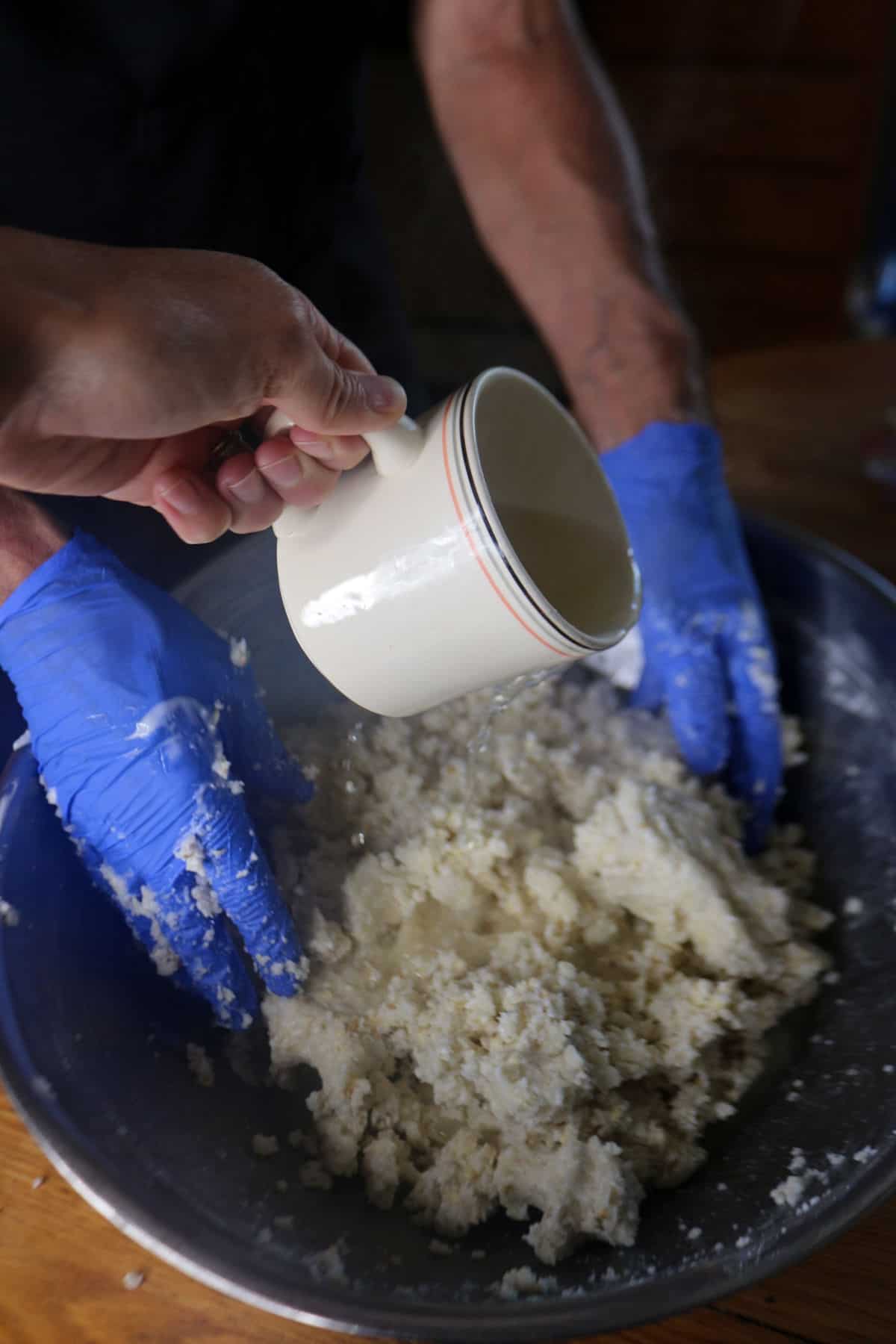
8. Add Broth: Add warm broth a cup at a time to the mixture. Knead the broth into the masa. Continue to add a cup of broth at a time until the masa reaches a spreadable consistency (like a thick cake batter).
9. Taste and Adjust Salt: Taste a little bit of the masa. It should taste like salt without being overly salty. If you cannot taste the salt, dissolve a teaspoon or two in a tablespoon of warm broth and mix into the masa. Taste again and repeat if needed.
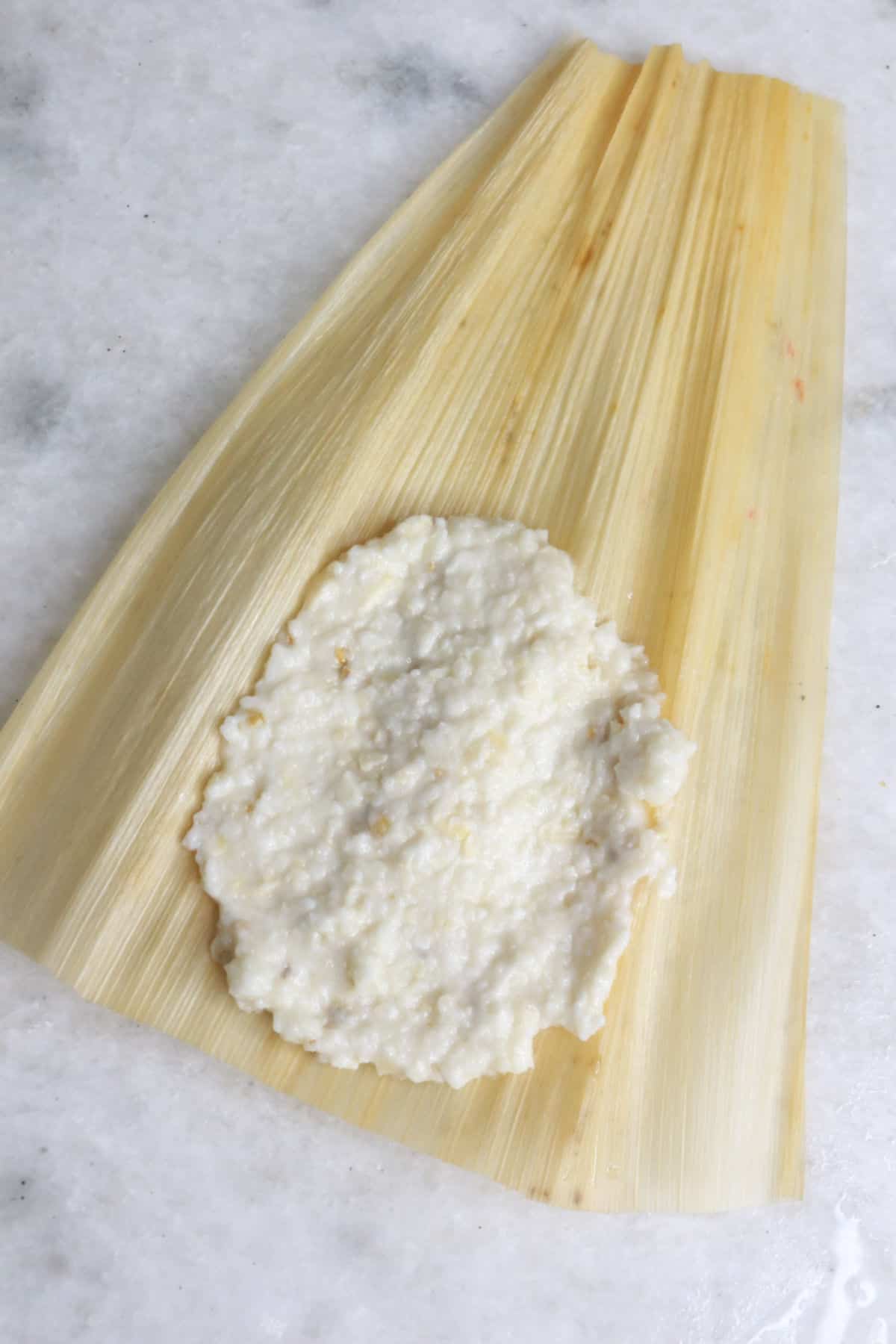
10. Make Tamales: Spread masa on rehydrated corn husks, add your favorite filling, and steam.
Fillings for Tamales
Your masa is now ready to create amazingly fluffy and delicious tamales!
Some of our favorite fillings for tamales include:
How to Store
Prepared masa will spoil rather quickly, especially due to the broth. Therefore, if you are not making your tamales right after preparing the masa, place the masa in an air-tight container and place in the refrigerator as soon as possible.
Refrigerated masa will stay fresh for up to 2 days or freeze it for up to 6 months.
If you do store your masa, be sure to taste it before making your tamales. Spoiled masa will have a sour flavor and scent. It is better to know ahead of time if the masa has spoiled instead of going through the time of creating tamales that you then can't enjoy.
Tips and Variations
- Use a Mixer: Instead of kneading the shortening with your hands, use a hand mixer or stand mixer to reach the indicated consistency. I do not recommend using a mixer to mix the shortening with the masa though, as the thickness of the masa could potentially overheat the motor.
- Buying Masa: If you want to skip the nixtamalization process, there are some tortillerias where you can buy the fresh, ground corn flour especially for tamales.
- Cooking Time: Different factors, like the age of the corn and elevation, can affect cooking time, therefore it is important to test the corn often to make sure it doesn't overcook.
FAQ
What is masa?
Masa is the word for dough. When referring to masa for tamales, you will hear the terms prepared masa and unprepared masa. Prepared masa refers to the dough that has shortening, broth, salt, and baking powder and is ready for tamales. Unprepared refers to just the plain nixtamalized, ground corn flour.
Can this masa be used for corn tortillas?
The texture of this masa is a bit coarser than what you want for corn tortillas. So you will need to make those adjustments to your molino or grind the corn twice if using a hand-crank mill.
I hope you enjoy! If you try this recipe, please leave me a comment with a star rating below. Also, be sure to follow me on Instagram, Facebook or Pinterest to stay in touch, and don't forget to subscribe to my newsletter.
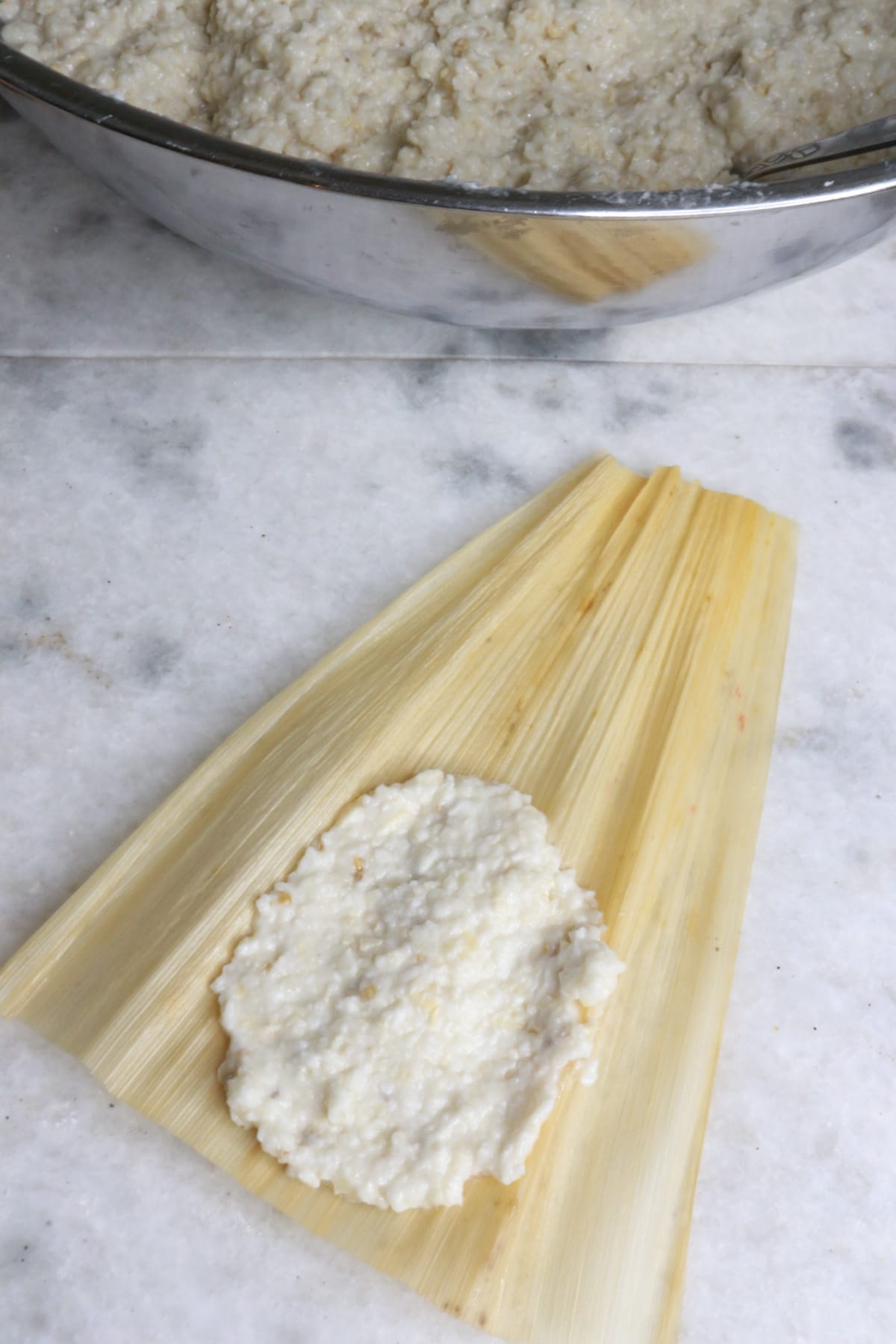
Recipe

How to Nixtamalize Corn for Tamales
Equipment
- Kitchen Scale
- Large pot
- Colander
- Hand-cranked grain mill or an electric corn mill
Ingredients
- 1190 grams dried white whole-kernel corn (or olotillo corn) about 2 pounds 10 ounces
- 2 teaspoon Calcium Hydroxide also known as hydrated lime, pickling lime, or cal
- Water
- ½ kilogram shortening or lard about 1.1 pounds
- 4 teaspoons kosher salt, plus more if needed
- 4 teaspoons baking powder
- 6-10 cups warm broth use the broth from the meat being used as a filling, or vegetable broth or chicken broth
Instructions
Nixtamalize Corn
- Add corn to a large pot. Fill pot with water, with a ratio of 4 parts water to 1 part corn.
- Sprinkle in the cal and mix thoroughly with the water.
- Bring to a boil and simmer uncovered for about 2 hours.
- At the 2 hour mark, begin checking to see if the skins of the corn easily rub off between your fingers and if the corn is al dente (medium-soft) when you bite into it. If not, continue to cook for another 15-30 minutes.
- Remove the pot from the heat and submerge it in an ice bath. Let the corn sit in the pot for 8-12 hours to allow the corn to steep in the cal solution.
- Using a colander, drain the corn and rinse under cold water. While rinsing, rub the corn pieces between your hands so that a majority of the outer skins fall off.
- Use either a hand-cranked grain mill or an electric corn mill (or molino) to grind the corn in batches, until no big pieces of corn are left. The final texture should be coarse, as opposed to fine.
Making the Masa for Tamales
- Place shortening in an extra-large mixing bowl. With clean hands, knead continuously for about 15-20 minutes until the shortening is soft, light, and creamy-smooth.
- Add salt and baking powder to the ground corn (masa) and mix to incorporate well.
- Slowly add the masa to the shortening and mix with your hands until well combined.
- Add warm broth a cup at a time to the mixture. Knead the broth into the masa and continue to add a cup of broth at a time until a spreadable consistency is reached. The masa should be smooth, not too wet and not too dry, like a thick cake batter.
- Taste a little bit of the masa. It should taste like salt without being overly salty. If not, dissolve two to three teaspoons in a tablespoon of warm broth and mix into the masa. Taste again and repeat if needed.
- Prepared masa will spoil rather quickly. If you are not making the tamales right away, be sure to refrigerate the masa in an air-tight container for up to 2 days or freeze for up to 6 months.
Notes
-
- Age of the corn and elevation can affect cooking time, therefore it is important to test the corn often to make sure it doesn't overcook.
- 1190 grams of dried corn will yield approximately 2 kilograms (4.4 pounds) of masa, which makes about 70 tamales.
- You can easily half the recipe for 35 tamales. Use 595 grams of dried corn, 1 teaspoon of cal, ¼ kilogram of shortening, 2 teaspoons of salt and 2 teaspoons of baking powder, and as much broth as needed for the correct consistency.
Orchardson, Emma. What is Nixtamalization? CIMMYT, March 23, 2021, https://www.cimmyt.org/news/what-is-nixtamalization/



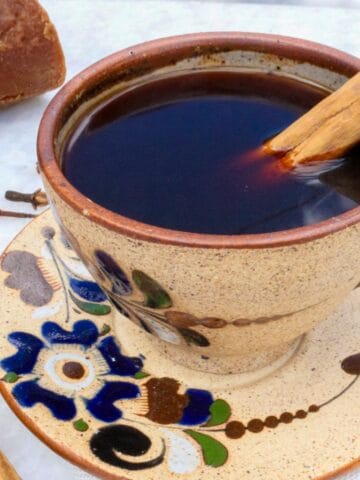
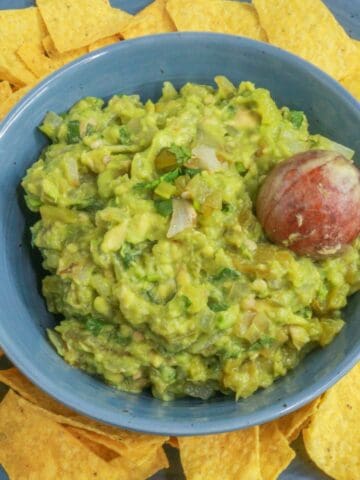
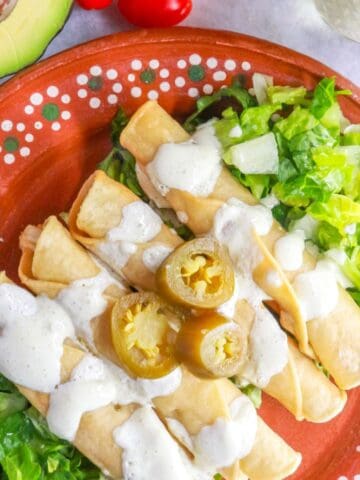

Alicia
I’m going to try these tamales for this holiday season! Awesome to find a recipe that gives step by step instructions to making nixtamalized masa dough.
I have a question about grinding the corn. If I don’t have a grain mill, can I use a food processor?
Gemma
Hi Alicia, sorry for the delay in responding. I am so excited for you to make these! Yes, you can use a food processor but be sure to avoid overloading the processor to ensure even grinding. I also suggest you pulse it and check it to make sure you get the right consistency and it doesn't end up being too fine, it should end up slightly coarse. I'd love to know how they turn out!
Rebecca
Wow! They came out so fluffy and light. My whole family helped me make them and it was so wonderful to make tamales from scratch together. Thank you!
Gemma
I am so happy you and your family made these and liked them. They are truly the best!
Lola
Wow, amazing! Love that the masa truly made from scratch for these tamales.
Gemma
It is an endeavour but it leads to such amazing results!